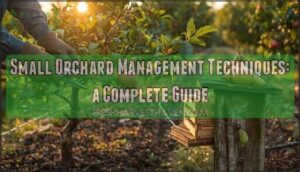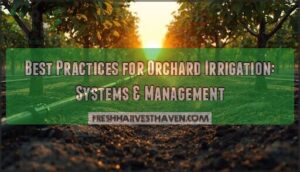This site is supported by our readers. We may earn a commission, at no cost to you, if you purchase through links.

To get started, you’ll choose a variety that suits your climate and prepare the soil with organic matter.
Planting requirements and techniques are vital, so you’ll want to make certain your strawberries receive adequate sunlight and water.
With proper care, including fertilization and pest management, you’ll be enjoying a bountiful harvest in no time.
Now, let’s get into the nitty-gritty of how to grow organic strawberries, and discover the tips that’ll make your strawberry patch thrive.
Table Of Contents
Key Takeaways
- You’ll want to choose a strawberry variety that suits your climate and prepare the soil with organic matter to get started with growing organic strawberries.
- To ensure a healthy crop, you’ll need to provide your strawberries with adequate sunlight, water, and fertilization, and keep an eye out for pests and diseases.
- Mastering techniques like mulching, weed control, and pruning will help you optimize your strawberry yield and enjoy a bountiful harvest.
- When it’s time to harvest, you’ll know your strawberries are ready when they’re fully red, and you can enjoy them fresh, frozen, or preserved, and even share them with friends and family.
Growing Organic Strawberries
You’re about to learn how to grow organic strawberries, a process that requires careful planning and attention to detail.
Grow organic strawberries with careful planning and attention to detail for a healthy harvest
By following the right techniques, you’ll be able to cultivate healthy and productive strawberry plants that yield delicious fruit.
Choosing The Right Variety
When choosing between strawberry varieties, you’ll find three main types that’ll shape your harvest timeline.
June bearers deliver one massive crop in early summer, perfect for jam-making marathons.
Ever bearers and day neutrals provide smaller, continuous harvests throughout the season.
Alpine strawberries offer tiny but intensely flavored fruits, while hybrid varieties typically produce larger berries with better disease resistance.
Understanding the different strawberry varieties is essential for a successful harvest of strawberry crops.
Planting Requirements and Techniques
Getting off on the right foot with strawberries means dialing in your planting game. Use these data-backed techniques for success:
- Space plants 1 foot apart for proper root development.
- Aim for well-drained soil prepared with organic strawberry seeds or bare roots.
- Keep the crown placement at soil level—no burying!
- Splay roots evenly for strong growth.
Understanding the role of strawberry seeds is essential for a successful harvest.
Master strawberry planting techniques, and you’re golden.
Soil Preparation and Growing Conditions
A shovel and a dream are all you need to start.
Loamy soil, tested for ideal soil pH (5.5–6.8), and enriched with compost or wellrotted manure build strong roots.
Full sun boosts yield, while a solid drainage system keeps roots happy.
Below, see key guidelines to master soil preparation for organic strawberries.
Understanding the best soil options is essential for a successful harvest.
| Soil pH | Compost Usage | Loamy Soil | Drainage Systems |
|---|---|---|---|
| 5.5–6.8 | Add monthly | Best type | Essential |
| Test yearly | Boosts fertility | Holds nutrients | Prevents rot |
| Use lime if low | Use organics | Fluffy, not clay | Raised beds work |
| Monitor every season | Wellrotted manure best | Improves aeration | Mulch helps too |
The key to a healthy crop is in the details, and mastering these elements will lead to a bountiful yield.
With the right combination of full sun, loamy soil, and proper drainage systems, you will be on your way to growing delicious organic strawberries.
How to Grow Organic Strawberries
Now that you’ve selected your organic strawberry seeds, it’s time to grow them. You’ll want to create an environment that fosters healthy Fruit Formation.
Consider the following:
- Strawberry Nutrition relies on Soil Microbes, so use Compost Tea to boost their growth
- Practice Crop Rotation to maintain soil health
- Use organic gardening tips, like strawberry fertilizer, to promote growth
By following these tips, you’ll be well on your way to growing organic strawberries. Remember to prioritize soil quality and provide adequate care for your strawberry plant care needs. For ideal growth, consider using well-draining sandy loam.
Organic Strawberry Care
Once you’ve got your strawberry plants in the ground, proper care becomes your ticket to a bountiful harvest that’ll make your neighbors jealous.
The key lies in mastering three essential areas: consistent watering and strategic fertilization, proactive pest management, and effective mulching techniques.
Master consistent watering and fertilization for a thriving strawberry patch
This approach will help you achieve a successful harvest by focusing on these critical aspects of strawberry plant care.
Watering and Fertilization
With proper watering frequency and organic fertilizers, your strawberry plants will thrive like never before.
Water weekly with one inch, targeting roots rather than leaves. Use balanced organic fertilizer at planting, then switch to high-potassium during fruiting.
Blood meal provides excellent nitrogen management for early spring growth.
For ideal growth, consider amending soil health with compost and organic matter.
Monitor soil pH between 5.5-6.8 for perfect nutrient absorption and healthy organic strawberry nutrition.
Pest and Disease Management
Effective pest and pathogen management is key to a thriving organic strawberry patch. You’ll want to stay vigilant against common strawberry pests.
- Plant disease-free strawberries.
- Encourage beneficial insects.
- Use organic pesticides when needed.
- Practice crop rotation.
- Prioritize disease prevention with good air circulation.
Remember, sanitation is essential; remove any dead foliage. A primary concern is strawberry blossom blight that can devastate crops. This simple step cuts gray mold by 50% before it blooms.
You got this!
Mulching and Weed Control
You’ll use mulching and weed control techniques.
| Mulch Types | Weed Prevention |
|---|---|
| Organic | Handpulling |
| Inorganic | Shallow |
| Natural | Organic Herbicides |
Mulch retains soil moisture, aids pest control, and supports organic gardening methods.
Optimizing Strawberry Yield
You’re now ready to optimize your strawberry yield by implementing a few key strategies.
By providing adequate sunlight, maintaining soil quality, and pruning your plants, you’ll be able to maximize your harvest and enjoy a bountiful crop of delicious organic strawberries, which will help you to enjoy a great outcome.
Providing Adequate Sunlight
To boost your strawberry patch, remember sunlight is key.
Sunlight Duration is vital; aim for 6-8 hours of direct sunlight daily.
Ideal Exposure ensures better yields.
Don’t underestimate Shading Effects, which can hinder growth.
- South-facing locations maximize sunlight.
- Consider Latitude Impact on sunlight intensity.
- If needed, explore Artificial Lighting for growing organic strawberries.
With the correct sunlight, you’re well on your way to successful organic gardening!
Maintaining Soil Quality
You’ll frequently check soil pH, using organic amendments to achieve ideal levels.
Incorporate compost, aged manure, and drainage solutions to guarantee well-drained soil, promoting soil health and nutrient balance with organic fertilizers.
Pruning and Training Plants
You’ll master pruning and training plants by managing strawberry runners, allowing daughter plants to thrive.
Using pruning techniques to optimize fruit size, all while balancing reproductive efforts with vertical training for a bountiful harvest, is crucial for a successful yield.
You will also be using these techniques to optimize fruit size.
Harvesting Organic Strawberries
You’re now ready to harvest your organic strawberries, and this is vital to know the right timing and techniques.
You’ll learn how to pick your strawberries at the peak of ripeness, handle them gently, and store them properly to enjoy your freshly harvested strawberries.
Timing and Techniques
You harvest organic strawberries when they’re fully red.
- Peak harvest occurs 28-30 days after flowering
- Regular picking maximizes yield
- Seasons vary by variety and climate, consider proper spacing and soil preparation for growing organic strawberries.
To guarantee the best flavor, harvest during the early morning hours.
Handling and Storage
When handling freshly picked strawberries, gently wash them to remove dirt.
Store in airtight containers to maintain shelf life.
Consider freezing strawberries or exploring other preserving methods to enjoy them year-round, making the most of your strawberry harvesting and cleaning efforts with proper storage and recipes.
Enjoying Your Freshly Harvested Strawberries
After strawberry storage, it’s time for the best part! Enjoying your rewards after strawberry harvesting. Think about all the possibilities. You’ve earned it!
Here’s how to savor your organic strawberries:
- Blend Strawberry Smoothies.
- Explore Strawberry Recipes.
- Consider Strawberry Preservation.
- Practice Freezing Strawberries.
- Think about Gifting Strawberries; share the love and strawberry nutrition.
Frequently Asked Questions (FAQs)
How do you grow organic strawberries?
You’ll be thrilled to discover growing organic strawberries requires well-drained soil, full sun, and careful watering, making it a fun and rewarding experience with delicious results.
What is the best organic fertilizer for strawberries?
You’ll find balanced organic fertilizers with high phosphorus, like bone meal or fish meal, work best for promoting healthy strawberry growth and fruit production naturally.
Can strawberries be grown in indoor pots?
You can grow strawberries in indoor pots with proper care, using containers with good drainage and providing 6-8 hours of direct sunlight daily for ideal growth and fruit production.
How to save strawberry seeds for planting?
Verily, you’ll need to extract seeds from ripe fruit, dry them, and store in airtight containers to save strawberry seeds for planting, ensuring viability for future harvests, you see.
Are strawberry plants attractive to bees?
You’ll notice bees buzzing around strawberry blooms—they love those flowers for their pollen, even if the nectar’s not exceptional.
This partnership guarantees pollination, leading to bigger, juicier fruit.
The more bees, the merrier your berry patch!
Can I grow strawberries in a greenhouse?
Absolutely—you’ll get a head start on fruiting and can dodge pests or surprise cold snaps.
Just keep temperatures steady, provide pollination (a quick shake or bee buddy does the trick), and watch for humidity—strawberries hate soggy socks!
Do strawberries make good companion plants?
Strawberry sidekicks shine! Pair your patch with spinach, beans, or lettuce for a fruitful friendship that deters pests and boosts growth.
Avoid cabbage cousins—they’re more foe than friend.
Nature’s teamwork tastes as sweet as the harvest.
Conclusion
Much like Newton stood on the shoulders of giants, your success in how to grow organic strawberries builds on well-tested methods.
Keep your soil healthy, plants pruned, and irrigation steady, and you’ll boost both yield and flavor—no secret handshake required!
Consistent attention to pests and organic practices guarantees every berry is safe and satisfying. Now that you’ve got the science, grab your gloves.
You’re ready to enjoy the sweet rewards of your strawberry-growing adventure!
- https://www.mofga.org/resources/strawberries/growing-organic-strawberries/
- https://www.groworganic.com/blogs/articles/how-to-grow-big-strawberries-organically?srsltid=AfmBOoq3WH99E5DxY5MhPZHGgTxjVi52qZkiopcrOYJpc2H6y4ZXRWck
- https://www.mysoulfulhome.com/my-soulful-home/growing-strawberries-101-guide
- https://modernfarmer.com/2018/07/growing-and-caring-for-organic-strawberries/
- https://plantbreeding.ucdavis.edu/how-care-your-strawberry-plant








